While the title says it’s the best this year: it’s the best paint for ceilings every year. There are two things you might not know about how ceiling paint works. The best ceiling paint has stain-blocking power that wall paint does not have. But be aware of real stains such as from water drips. They need a primer.
If you want to read less, here is the quickie version…just on the top two ceiling paints.
First Big Tip for Painting a Ceiling: use the best ceiling paint to cut your work (and stress)
Our Top Choice: Benjamin Moore has the Best Paint for Ceiling
Even if my customers are on a budget, I explain, and they understand that it saves money to use the somewhat pricey Waterborne Ceiling Paint Ultra Flat from Benjamin Moore. It dries with a very good final thickness of 1.4 mil: like plastic sheeting. You can check the price online here.
It is without a doubt the best ceiling paint on the market and it’s a zero VOC paint (the toxins in most paints).
Covers 400-450 ft²/gallon.
Best Ceiling Paint – What kind of paint is best for ceilings in 2021?
Benjamin Moore is still the champ of ceiling white paint, but I’ve added a runner-up below.
You save time and money if you choose a long-lasting one-coat paint that you won’t need to repaint for a long time. The best ceiling paints hold their color (or whiteness) longer.
If you want to save money in the long run, you don’t want to be buying paint every 5 or even 10 years: you want your paint job to last. The paint you see shown here is a high-quality, ultra-flat latex ceiling white paint that does not yellow, and that covers the old paint in one coat.
Bottom line: Benjamin Moore’s Ceiling Paint costs a little more but it’s designed to cover in one. It will hide and cover most yellowing, aging, and stray puck marks from when you were playing hockey inside. (Puck marks need 2 coats!) How to paint a ceiling with many marks? Spot prime with the best primer for this type of work.
If the old ceiling is off-white or white, this paint covers in one coat. Non-white surfaces will need a primer first, or two coats of ceiling paint: a hard-fast rule when changing colors.
Good Value: Kilz Ceiling Paint Stainblocking
You probably have some sort of stain or marks up there, right? Over the years, the old paint has yellowed.
What is special about ceiling paint?
You want to hide these yellowing spots, bump marks and the dreaded water leak from your crazy cousin Ernie’s annual bath.
Kilz was smart to add a stain-blocking resin to their Kilz ceiling paint.
- Dries in about an hour, depending on humidity
- Water clean up
- 250 sq. ft. per gallon on new drywall, 400-450 when repainting
- Rolls on pink and turns white when dry, meh
- Kilz admits you may need 2 coats (or more)
Can you use regular paint for ceilings?
 Sure, but unlike the paints in my review here, normal paints contain an average amount of solids and no stain blockers (unless they say so). My recommendations for the best ceiling paint do and will cover better, it’s that simple. Use a good roller and check out my tip below for saving enormous time (if you are also doing the walls). If you use white wall paint instead of ceiling white paint, prime your stains first with a good stain-blocking primer.
Sure, but unlike the paints in my review here, normal paints contain an average amount of solids and no stain blockers (unless they say so). My recommendations for the best ceiling paint do and will cover better, it’s that simple. Use a good roller and check out my tip below for saving enormous time (if you are also doing the walls). If you use white wall paint instead of ceiling white paint, prime your stains first with a good stain-blocking primer.
Read one painter’s blog on this.
How to paint a ceiling that is new drywall:
You definitely need a primer to hide the tape from the rest of the sheetrock, but then you only need one coat of the Ben Moore I reviewed above. Without a primer, you’ll see the rock boundaries. But this is the one and only time that new sheetrock only needs two coats (primer plus a quality ceiling paint).
Which emulsion is best for ceilings?
When shopping, look for the paint’s claim of added ‘stain blockers’ in the solution. The chemists at these companies know you want to cover yellowing and stains. And your kid’s hockey puck marks.
Understanding ‘volume solids’ allows you to know the true cost of different coatings and to know how much paint is being used to perform its function. Generally, more expensive paints have a higher volume of solids and therefore provide better coverage.
Sealers only provide 10-25% solids whereas most household paints will leave 25-45% of the contents of the can on the wall. Two-part epoxies can be as much as 100% as they cure by a chemical reaction, not by evaporation.
Spraying a ceiling?
If you have a lot of rooms to do, yes, I would recommend spraying, and if you have textured ceilings, spraying is really the only way to go. Here is a short article on good sprayers for homeowners.
But when I’m doing one or two or three rooms only, I roll and brush even very large flat surfaced ceilings. Another reason to use very flat white ceiling paint is that the small imperfections are well-hidden (higher gloss paints show imperfections). We have more tips below.
Doing walls? You can also read more about what makes the interior wall paint in our other post. It’s a no-brainer: I usually recommend Benjamin Moore paints (company website). They spend a lot of time researching longevity and durability. 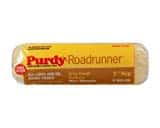
The second most important tip after choosing a good ceiling paint is to use a quality roller cover: budget rollers and brushes shed lint and bristles. Guess where the lint ends up? Did you ever feel a wall that is rough like sandpaper? That’s lint from the roller cover. Another reason that buying budget tools is more expensive in the long run.
The roller cover you see here is 50% wool and 50% poly. Wool for absorbancy, poly for longevity. It’s a pro cover, but it’s not expensive. One of these lasts me for months of daily use. Anything less sheds lint. Here is a short article just recommending some good roller covers.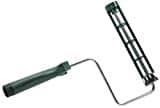
Also, you need a strong roller frame that will last you a lifetime. With a good frame, you can use force to push a roller into the corners instead of a brush (video below explains). The type that comes in a kit with the pan etc, will bend easily. We also have written about power rollers: worth it if you paint often.
If you are painting ONLY a ceiling and no walls or trim, skip to the last paragraph “Just painting the ceiling“.
- Read about how rollers are easy to clean.
- Read how to easily clean a quality brush.
- At the very bottom is the chart that links to some of the affordable tools I use. (Full tool page is here.)
How to Paint a Ceiling: KEY Point When Doing Only One Coat
What you don’t want to hear: “You missed a spot”. When doing only one coat, you must go slow and make sure you cover the entire ceiling with a full coat. This is why, on walls, we do 2 quickies: it’s easier. But ceilings are hard work and can injure your neck. You always want to just do one coat when working above your head when possible: and the Ben Moore paint makes this possible.
Use a very bright work light. Look at the entire ceiling from different angles.
One key point here is the quality of the roller ‘cover’ or ‘sleeve’. Again, I stick with a wool/poly blended cover (shown above).
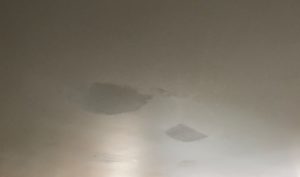
We use this term “flashing”. This is when you can see the difference between old paint and new, or between one coat and two. Eggshell builds in sheen: 3 is glossier than 2 coats.
When the paint you are using is either flatter or glossier than what you are using, and if you miss a spot, it will ‘flash’. It stands out like a sore thumb. That’s if anyone ever looks up, which they don’t really do.
So even doing 2 coats missing a section with one coat will cause some flashing.
Sure, you can touch up skipped spots later and it will be better, but it’s not ideal.
Key tip: inspect the job BEFORE you clean up!
Best Ceiling Paint for Old Painted Ceiling with Discoloration/Stains
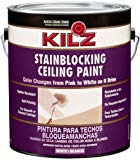 If your old painted ceiling has some discoloration you need stain-blocking resins in your paint/primer. Go with the runner-up of ceiling paints, Kilz Color-Change Ceiling Paint, check price here (turns white when dry). It blocks discolorations better than the Ben Moore above, and it will also act as a primer if you have a new drywall ceiling/walls. This paint may require 2 coats.
If your old painted ceiling has some discoloration you need stain-blocking resins in your paint/primer. Go with the runner-up of ceiling paints, Kilz Color-Change Ceiling Paint, check price here (turns white when dry). It blocks discolorations better than the Ben Moore above, and it will also act as a primer if you have a new drywall ceiling/walls. This paint may require 2 coats.
For real water stains (clearly brown/tan), spot prime water stains, etc., with a primer with stain-blocking power. New drywall ceilings need 2 coats, but you might be able to do one drywall primer and one latex ceiling paint. I would not clean the roller when making the switch from one white to another: just squeegee out most of the old white and dunk the roller in new white paint.
Also doing walls? Here is a big time-saving tip:
Brush? On a ceiling?
No, my friend, don’t work so hard. Don’t work so long.
Our secret Professional Ceiling Painting Tip: Eliminate (Almost) the Brushing
When you are doing both the ceiling and the wall, there is no need for brushing when you use a quality paint roller and frame. A longer nap roller works better than shorter, but both can do this. This Wooster ¾-inch roller cover is great…used with a high-quality ceiling paint you’ll be laughing. (The roller cover shown at the top has a choice of nap length also).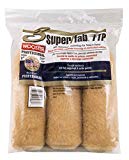
In the corners where 3 surfaces meet, yes a little brushing is necessary and of course around the lights, etc, but not the long sections where walls meet the ceiling. I know painters who have not thought of this: they still waste tons of time dragging a ladder around and brushing the joint where the wall meets the ceiling.
What do you do? Here is a video showing what to do (this video is also at the end of the post). Here I’m demonstrating with a silly 3-inch roller, but you will use a 9-inch. Just push your roller into the corner getting ceiling paint all over both surfaces. No cutting the ceiling. Let it dry and then cut walls only. It’s good to smooth out any mounds of paint as you smoosh with the roller: they might start to drip, or show as small mounds when dry.
How do you paint a ceiling with a roller and almost no brushing?
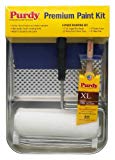
- Dip roller with a good deal of ceiling paint (just so it’s not dripping)
- Push paint into the ceiling corner and slide maybe a foot or 2 or 3 to one side
- Lift the roller and rotate the roller cylinder about 1/3 turn for more paint
- Repeat steps 1-3 until the roller is too dry
- Tip: push harder as the roller get empty of paint (less dipping)
- Be sure to fill all of the corners
- Don’t leave 3-D gobs—they will show when dry
This is nothing wrong with using your roller as a brush!
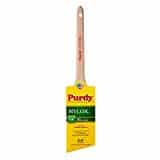
You don’t have to worry about getting ceiling paint on the wall as you will be painting over it soon anyway! Learn how to not drip at my post about paint walls or trim first.
If using a high-quality latex ceiling paint and a good brush, as shown here, you will only have to ‘cut’ (brush) only once. Let the paint dry, then with a good brush, lay your wall color right up to the corner you filled in with white ceiling paint. Brushes with poorly made bristles (cost about 7 bucks) will not give you a nice clean line(plus the bristles fall out). The line somewhat makes itself with a good Purdy brush and they never shed bristles. A Purdy will last you a lifetime if you remove 99% of the paint in it each time you clean it.
It may cost 15-20 dollars, but your frustration with the lesser ones makes this one worth it.
To make this method work at it’s best, long roller nap length is helpful
The best is a long nap paint roller cover: we like a ¾ inch (or more), in a wool/poly blend. A nap of 1-inch or even 1¼ can work. Longer naps leave a slightly different dimple pattern on the wall, but that is not important to us—if it is to you, go with a short nap “designed” for walls, but they don’t hold as much paint and you have to dip them more often. Yes, the stipple pattern is nicer.
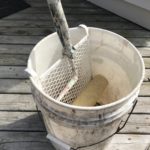
We use only Wooster or Purdy paint roller covers: the poly gives longevity and the wool sucks up the paint. The Wooster ¾ inch wool blend is only about 7 bucks (sometimes as low as 3!) A better value is to buy a pack of three and not worry about getting more later. This will last a homeowner a lifetime. Learn how to quickly clean paint rollers.
Pros don’t use trays: the screen and bucket etc you see here are all on our tools page. Did you ever kick and spill a tray? The bucket and screen system is just so much better.
Most people say ceiling paint should be a flat finish.
People want their ceilings to be white because the reflection multiplies your lighting and makes the room feel bigger. True. We always recommend a flat latex white ceiling paint, and flat on walls if the home has no children. The flat sheen in most paints will show handprints easily, and is difficult to clean: but how often does someone put hands on a ceiling?
Plus, the flat sheen is soft and does not draw attention to itself. Designers say: more sheen, more attention. Shineyness makes you look, so flat ceiling latex paint is the norm for good reason.
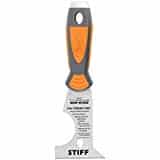 A tip you might use if you are later painting any other white or off-white: don’t clean your roller and brush after you are done with the ceiling: just use the curve in your multi-tool to scrape most of the flat ceiling paint out of the roller, then just smoosh the brush’s fibers/bristles of old paint and go right into your other white paint. Before applying your new paint, soak up a lot and work it in and out of the roller/brush: you are all set to go. (Don’t tell the boss you do this!—but it won’t matter at all in the end and save time cleaning-whew).
A tip you might use if you are later painting any other white or off-white: don’t clean your roller and brush after you are done with the ceiling: just use the curve in your multi-tool to scrape most of the flat ceiling paint out of the roller, then just smoosh the brush’s fibers/bristles of old paint and go right into your other white paint. Before applying your new paint, soak up a lot and work it in and out of the roller/brush: you are all set to go. (Don’t tell the boss you do this!—but it won’t matter at all in the end and save time cleaning-whew).
Just Painting the Ceiling? Big Tip:
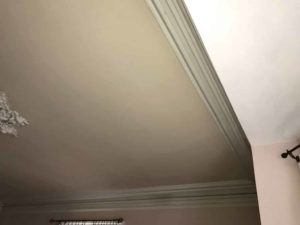
Obviously, be sure to protect your floor and furnishings from drips: tape some light plastic to the walls near the ceiling and remove the art or carefully cover with the plastic. If you use old bedsheets etc to cover things, be sure to wipe any drips as they happen because sheets will allow the paint to bleed through onto your things.
Do You Paint Walls or Trim First?
As with all paint jobs paint the TRIM FIRST. Why? It is by far much easier to brush the line on the wall instead of the trim. If doing only one coat, paint the trim carefully making sure not to leave any skips, and feel free to get your trim paint on the wall.
The proper way to paint walls: Roll or brush first?
After the trim paint dries, roll the wall as close as you can to the trim without touching (obviously). Then “cut” with a good quality brush, we like Purdy latex-only brushes shown above. The quality bristles will find the corner for you and you don’t really even need a very steady hand. Get the 2-inch ( or 3 if you have a strong arm, as it is heavy when wet!). This brush will work like new for life (see my post on how easy it is to clean up).
This post explains in more detail why you should paint the trim first.
Drop cloths: be happy and get a canvas for the floors and plastic for the furniture.
The plain canvas is fine and the best value. But if you can afford it, go for the one that will not slip around as you walk on it: a constant source of worry for us. (The photo is a link to a different size.) buy a large and cut it into thinner ‘runners’ for against a wall.
Even paint spills are no problem (should you ‘kick the bucket’ while looking up as you paint your ceiling)! 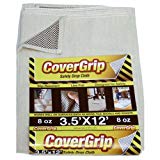
I avoid very thin plastic. I prefer the 1-Mil thickness because it tends to stay put, and I use green painter’s tape to hold it in place. If you are only painting a ceiling, this is a must: you simply cover the walls, bringing the edge of the plastic near the top.
These drop cloths are also useful at home for all kinds of projects.
Large ceiling? Do you have other projects lined up for the future? Spray that puppy. With any ceiling paint, you will cut your time tremendously.
Spray painting a ceiling is 10 times faster than rolling. Painting a ceiling is the most painful thing a painter does.
Two recommendations for two budgets:
- The best non-commercial paint sprayer today is hands down the Graco Magnum. It’s pricey but will last a lifetime with proper care. We have an entire post showing quality sprayers for different budgets.
- The budget version is the Wagner Flexio 590. It has a very reasonable price for what you get. These are slower than airless but are good all-around units.
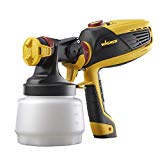
- We never spray without a respirator, never ever. I have simplified the complex world of filters etc, but most people tell me they like the big dog full face mask you see below.
Two paint sprayers brands you can trust are Graco and Wagner. If and when you need parts, (the tips do wear out in time) you can find them easily if you go with a major brand. 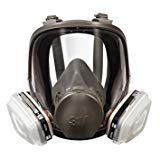
Some keys to spraying paint
- Use paper and plastic and tape to mask what is not getting painted. Take your time masking–you’ll save a lot more time in the end. Below is the graphic that will take you to all this.
- Practice first: move your hand at a uniform speed, and when you change direction, you make a quick flick of the wrist so you don’t have paint build-up (sags and runs).
- Soak the sprayer nozzle right away when on a break: this is normally going to be water, but if you spray oil, it’s paint thinner. Have your cleanup station ready–don’t let your tip get dry.
- This is all explained further in the sprayers for homeowners post.
Have a question about the best paint for a ceiling? Please write a comment—I’ll try to reply asap!
Related:
- Best drywall primer
- Be sure to select all the painter tools that you need: surprisingly not expensive
How to efficiently apply a good quality ceiling paint:

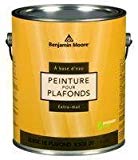

I believe my ceilings were last painted with BM Muresco. It’s not terribly white and has no stains, but there are some cracks that I am repairing due to it being an old, 1800s home. When I repaint, I’m not trying to completely match it to the rest of the ceilings, but I also don’t want it to be completely bright white.
Is the BM Waterbourne a brighter white than Muresco?
What are your thoughts about using Muresco rather than Waterbourne?
Thinking about this… the best way to see brightness is to get samples and tape them to the ceiling, or just look in stores. Key point is flatness. You want ultra flat which shows handprints, but who puts hands on ceilings… and flat and matte hide imperfections…we all use them on ceilings. Good luck!
Thanks
great website. Just painted ceiling with BM waterborne ceiling paint.
thoughts on using this on the wall ?
Well, it’s uber-flat so when you touch it with your hands it will leave a mark. I guess it may clean easily, but not sure.
I’d go with a flat or matte made for walls that we know is clean-able. By the way, most company’s flat paints are not at all clean-able.
They smear. Ben and Sherwin Williams are much better, but still, if you have children go with at least eggshell or some gloss over flat.
Every line of paint has different divisions, even diff. lines within one company will not have equal sheen from, for example, one eggshell to another.
I like flat paint best on walls: Looks best and slightly absorbs sounds, unlike gloss which sounds like a bathroom tile wall somewhat.
Hi Brad!
Thanks for giving out advice! I recently de-popcorned the ceiling in my living room and then did 3 skim coats of mud on both the ceiling and walls. I managed to get the walls sanded pretty smooth but the ceiling mud shows little crevices-even though I thought I got it fairly smooth. I just put on a layer of Glidden Pink to White Ceiling Paint and Primer and I was hoping it would fill in the little crevices and look smoother–but it doesnt seem to be doing so.
Is there another Primer I could add over the Glidden that would smooth things out a little more–and if so–what would you recommend. And what topcoat paint? Would it be best if I put on two top coats on top of the additional primer (making it 4 layers total) or will this not really cover the crevices? Or should I just give it up and sand and re-mud the ceiling?
I dont mind painting the ceiling, but at 5’9 I’m having to spend a lot of time on stepladders to mud and sand the ceiling and I really dont want to do any more of that if there are ways to improve it with painting. I’m not expecting perfection-just trying to make things look at good as I can.
Any guidance you can give will be greatly appreciated!
Cameron
Hi. I should write an article…”Does Paint fill cracks?” and the text would be one word…. ‘nope’.
Paint just follows the contours of what you lay it on.
There are some paints designed to fill hairline cracks however.
But for your situation, now that you have coated all the mud, it’s too late to sand again…well, you could but it’s hard work and paint really is not made for sanding. Primers can be. There is Zinsser Block Filler and one for evening out paint chips called Peel Stop. I have never used them.
I would spackle in spots, sand, prime and paint. Seems you’re skilled now! Should go fast.
A small rolling scaffold is helpful and comes in handy in many small jobs around the house…Mine does.
Doing all the spots may seem like a full skim coat if you have cracks every few inches, but I don’t know that you do. Maybe one last thin skim coat using a ‘topcoat’ mud…made for easy sanding … could be the thing.
YOu might have a painter/mudder come over and give you a price and you can pick their brains.
Good luck.
Great website! Love how responsive you are with such prompt and detailed feedback.
Now, I am a real rookie and painted the walls first, then baseboard trim… and now I’m kicking myself because I know the ceilings need to be done after looking up at them for the last 3 weeks………. I thought about taping off the walls with attached plastic sheeting to get crisp lines where ceiling meets wall.
Suggestions?
Exactly. Do exactly that. Don’t be afraid to go fast, then come back and re-cut your line with wall paint. In the end, you don’t really lose that much time. Not bad for a rook!
b
if i re-cut the wall paint, will it show since i already painted the walls? I’m using SW emerald and the walls have been done for a couple weeks now.
Not really. Yes up close witha bright light and magnifying glass… but if the paint is from the same can… no.
A new can? Yes a bit. All cans are mixed ever so slightly differently. Hard to tell. We always combine 2 when we know we need two gallons. That way you get the average. but they look the same almost 100% of the time.
I am changing my dining room wall from maroon to off white. Do you suggest a primer first then paint or should I use the Kiltz paint as a primer. I always use B M paint as a top paint and have for 40 years, just not sure of the best way to cover ( or seal) the red from bleed thru.
Thanks
Yes a primer will make coverage work. 2 coats of white over maroon probably will not be enough so use drywall primer since it costs the least as your first coat, then your top coats will look great. You may not need 2 brushings in the corners, but test it.
B
Discovered your site today and couldn’t be happier than a pig rolling in…paint? Can use some guidance. We live in a 20 story apartment building built around 1960; concrete ceilings I believe. The consensus (seems systemic throughout the building) is that something was not set right with the concrete and the ceilings are susceptible to minor cracks and bulges. In the past, when patching a small crack/bulge and scraping first, it could sometimes lead to a significant amount of paint (and plaster?) coming off, then requiring a bigger plaster patch. Planning to paint this summer and once fixing all the mini-cracks and bulges, is there any sort of primer I can use, or paint, to repel cracking and improve overall bonding/adherence? When we moved in 20 years ago, we hired someone to do patching and skim-coating but it has since become whack-a-mole. Thanks!
If you are doing one ceiling, I might take a stab at this, but if you are doing many units, call an old pro to see it.
Doing one, I would scrape and wire brush until all that will come off, comes off.
Then I’d use STIX by ben moore. I’d probably even do 2 coats, then one of BM Ceiling white.
That should do it.
If you have moisture behind the concrete or plaster (I suspect it is really hard plaster from that era), nothing will stick for long. Moisture wins always.
If doing many units, I’d do one room of one unit first and give it a year.
But an old pro, not a young one, should see it and recommend what to do. Also a big paint store manager will come out and help if you are buying big.
Go with a BM or Sherwin W. store, they have the best people.
Good luck
b
Hello, I’m in the process of removing (scraping) popcorn ceiling from all the rooms in my 1400sqft house. I started in the guest bathroom and hallway, since the areas are smaller and so I can learn from my mistakes. Some areas of drywall where the joint tape was loose from scraping needed joint compound. I’ve sanded the ceiling smooth 150grit. I’m planning on rolling, since I’m doing one room at a time. Is there a good method for scraping the popcorn where the wall meets the ceiling, so the joint tape isn’t damaged? What is the best primer to use with Benjamin Moore Waterborne Ceiling Paint Ultra Flat? What is the best roller to use?
Yes there is this product you attach to your vac. The primer to use is most likely drywall primer shown here, but if you have water stains, they will bleed through. Read about stain-blocking primers if so.
Good luck!
LOVE your site. Very good information.
What is the difference between Ben Moore Waterborne and Muresco for ceilings? My main objective is to get these massive ceilings done in one coat. They are white, but dingy with a few minor stains since they haven’t been painted since the ’60s but in good shape otherwise.
For walls, what is the difference between flat and matte finish. I thought they were interchangeable but finding they are both choices with some brands. Def. don’t want flat on walls. What’s the sheen difference between matte and eggshell. Even though I’ll use a longer nap on my roller we really need to hide imperfections. THANKS!
Hi and thanks for the nice words. We usually call what you called ‘waterborne’ we usually call “Benjamin Moore Ceiling Paint”. (I know, not full name!)
The difference is the coverage. Muresco does not have the amount of solids, which is what is left on the surface when it dries.
If your ceilings are dingy, it may be hard to get them in one. Buy one can of “Ceiling Paint” … yellow label… and do a test. You can wrap your roller and keep in the fridge while you get the rest of the paint delivered unless you have to go out.
The dark marks? Definitely hit with a coat of the same paint “spot prime” but not with primer. They’ll take 2 and they may be whiter than the surrounding area when you are done…but not a big deal.
50 years of no paint? I’d plan on 2. Sorry, but just take your time and when your neck gets sore, go do another task for a while. That’s what I do. Just cover your bucket/pan and roller/brush with a damp cloth or plastic so they don’t dry out.
Overnight too, but add 1//4 cup water on top of the paint.
Flat vs Matte. Each line of paint divides the gloss scale differently. Some only have 3 sheens while others have 5 or 6. So for those with many, they divide the flat ones. USUALLY matte is flatter…less glossy… than ‘flat’.
You can easily see the gradation on the maker’s website. If you cannot, tell me which line of paint (BenM has maybe 20 lines of paint).
Matte vs. eggshell: Eggshell has some definite gloss and the gloss builds with each coat. Almost all interior designers use this everywhere now…even shower stall ceilings as they can be wiped like a gloss and leave no marks. Flat can leave marks when you wipe. Ben Moore flats are the best there. I have not experimented lately but they are improving that all the time.
Nap length: not that important. Longer holds more paint and you dip less, but leaves a raggedy ‘texture’ or nap marks. I could never care less, but some of my customers want a nice uniform ‘orange peel’ roller marks. Meh.
Ok, let me know if I can help more.
Enjoy and protect your neck!
b
I was told I can do one coat of flat white SW Superpaint on a ceiling. Flat white over a light/med flat taupe. I’m concerned about 1 coat vs. 2, my rolling skills are above average. Thoughts?
That’s a great paint and could possibly cover in one.
I’d be ready for the disappointment of needing a 2nd.
If you do need 2, probably the cut (brushing) will be ok with one…it goes on thicker witha brush.
Use that wool/poly roller cover for the best, thickest coat.
Good luck!
Update: I got it to cover in one. Had to go back and touch up edges. Seemed to coat better with the roller vs. brush. Could have been my skills too. Used an 18 inch roller for most of it. Laid it on thick. Happy with it. I appreciate your reply and love the website.
Awesome. You’re hired!
Thank you for the quick reply and advice. This will be the most complicated painting I’ve tackled and will be done slow-ish as I have a 13 month old.
I’ve looked at your tools pages and am considering a REXBETI for another project in the works…I will try the bucket instead of the tray.
And when in doubt, a margarita for courage!
Good luck!
Hi Brad,
I’m contemplating the most efficient way to tackle two 15.5’ x 15.5’ rooms each with a 10’ recessed lit tray ceiling, a set of 15 pane French doors plus two 9 over 9 windows & a built in wall bookcase. Moulding/casing is simple craftsman style. I will be changing all colors. Currently each room is three medium colors (yellow ochre to rust – ceiling Flat, walls Flat, trim semi gloss.). New colors (3 colors as well) will be lighter so I will need to prime definitely. (New Finishes most likely will be flat for walls, semi for trim and tray ceiling. I need to bounce the light around as rooms are Northwest facing with trees making them darker.)
I was thinking of spraying primer for entire rooms. I have experience with rolling/brush but none with a sprayer. House will be occupied during painting but will need to move covered furniture from room to room as I go. I understand how much prep work is needed with spraying…would you spray walls and then roll ceiling and trim?
What are your thoughts on how to best tackle this?
Thanks,
Christina
Hi. Sounds like a worthwhile project. Well, pros would do all the priming at once. The walls you might prime with a nice latex primer and the trim (bookcases too) would probably need something like Stix.Spraying is probably out for the trim with all the glass you would have to mask, but a sprayer would do the bookcases in no time…
If you walls are not stained etc, just use drywall primer or Kilx Premium from that same link above.
No need for much money there.
Setting up and cleaning an airless for 3 coats in 2 rooms is iffy… and just for primer would be right out. I wouldn’t spray walls/ceilings. IT’s just too small for all that…but would be faster. Remember, you have to clean the sprayer between all colors, except from white primer to ceiling paint.
See my sprayer post and look at the Magnum X5 or X7 if you get serious about spraying.
Get good roller covers, that’s key. The 50/50 poly-wool on my tools page is the thing. A nice long nap holds a lot of paint, since you say you have experience.
But generally, in answer to your main Q:
After giving all a quick sanding to knock off the old ticks, wipe with damp cloth then do the priming, then the ceiling (if in good shape, no primer, just one coat of Ben Moore), then the trim (all same color or not), then the walls. Mask baseboards while doing walls. Then touch up any trim you hit.
Since you’ll be working at night and on weekends…I assume…in any case over a number of days… Get good plastic bags to wrap roller covers while working in the same colors. Or to cover you 5-gallon bucket.
A job this size with roller pans? No way. Get the 5-gallon bucket and screen on my tools page. You’ll fly. You can soak a good roller for days …just keep it wet and keep the top covered overnight.
If you care to take before and after pics, I’ll post here for you (no faces please).
Good luck! Have fun. Beer helps.
Brad
I WOULD LOVE TO SEE SOMEONE ACTUALLY PAINT A CEILING WITH JUST A ROLLER AS YOU CLAIM HERE…WITHOUT TOUCHING THE WALLS AND STILL CREATE A STRAIGHT LINE..
I SAY IT can not BE DONE
Since I’m in retirement, I have not done any lately. I will certainly do it for you, but you can try it: load up your roller and smoosh into the corner…then you only need to cut the wall color, not the ceiling. I’m not saying to NOT touch the wall…Of course you have to hit wall. Then it dries, and you simply paint the wall to the corner.
Why do you recommend 3/4″ Purdy Roadrunner roller cover for painting ceilings and not the Dove model? I’m painting over someone’s old paint. I checked Lowes to get it tomorrow and they don’t have Roadrunner model in Purdy. LOVE your website and everything you do!
Thanks, Ilene
Thanks for the nice words. I use Dove if that is the roller cover that jumps out at me. But my philosopy is 50/50 poly wool.
Roll on!
I painted my kitchen ceiling for the first time In 10 years and now see there are lots of streaks and lines. So I probably should do it all again and paint using the roller only in one direction, is that correct? Will it cover my first bad paint job?!
HI. No, it’s not the direction, it’s the overlap most likely. My suggestion is to get the Roadrunner roller cover which is 50-50 wool and polyester.
Maybe a 3/4 nap and roll your section … a square of maybe a yard, then before dipping with your now ‘dry’ roller, lightly ‘backroll’ the square. This means roll lightly for an even stipple.
Start your next square and try to keep as many edges ‘wet’ as you can. Wet means to keep from becoming tacky before you overlap the next square.
Good luck!
b
I just bought Sherwin Williams Emerald ceiling paint – Should I use it for my bathroom or return it for Benjamin Moore?
Hi. That is probably a flat paint, right? Ceiling paint usually is. People don’t put flat on bath walls in general: the tread has been eggshell for the past decade or so: a good quality paint can be scrubbed. Yes, SW is one great paint, so I’d return and change the sheen. Should be no charge.
Brad thank for your reply. They did suggest the satin for the bathroom ceiling( as my husband likes steamy showers) but flat for the bedroom ceiling. Is this a correct recommendation?
Especially for bathrooms, it is a good idea. Flat is the industry standard for all other ceilings, but it’s a matter of taste: flat tends to get marked up with hands…so keep your hands off those other ceilings!
Hi Brad. Thanks again for all this information. Another couple of dumb questions. Regarding crown molding and painting ceiling. I’m thinking I paint the crown molding as I would the door/window trim first and then the ceiling as though it is a wall? Getting as close as possible to molding with roller and then using brush? So, (1) is it ok to let ceiling paint dry and then go in with brush or should I go in with brush while ceiling paint is still wet? Not sure if I can be that fast…(2) how do i protect the various moldings/trim from rolling spatter? Thanks again for your time?
Hi Brad! We’ve never painted our ceilings since we moved in 15 years ago. I will definitely use the BM that you recommended. But do I need it to prime the ceilings? Thank you for your posts and for the answers to other questions here. They’re very helpful.
Hi. I’d say not unless you have some staining. If just normal age discoloring, we get our ceilings done with one coat of the good stuff. But please do a test: roll a section over some bad discoloration and wait and look with a bright light. If very discolored, use a primer or do 2 coats of the top coat. Good luck
Hi! Will Waterborne BM cover a tan ceiling in one coat? Thank you
Hi. It’s unlikely. The ceiling paint on this page (the good one with the yellow label) will cover an old ceiling in one coat, if it’s white and not stained, for example a primer will be covered well. A color, not so much
But remember that 2 quickies are better and even faster sometimes than trying to get it all done in one swoop. Just choose a good poly/wool roller and apply with a light so you don’t miss spots. What looks perfect when wet will clearly need a 2nd coat when dry. Good luck!
Thank you for getting back so quickly! I will paint the way you recommend with the BM yellow label and have good wool rollers. One last question…should I go with the streaks length wise along the length of the room? Or, against them across? Thanks!
The direction that you roll and brush is not so important … it should not show in the end. We have a post on how to paint a room… We think in blocks. That is, one meter square, or if your roller can hold more paint, 2 or 3 square yards or meters etc. Long strips can show. Key point is to keep the ‘wet edge’ of the squares/blocks/rectangles as you roll. If it is allowed to dry, it does have a way of standing out later. We cannot prevent some of this without spraying, but as I tell customers: only you and I will see these small imperfections.
Good luck!
We have a smooth ceiling that the builder sprayed off white. I painted the ceilings with Behr white ceiling paint (I know..) three coats and I can see long streaks of what looks like poor finish work on the ceiling. Will BM Waterborne paint help disguise these imperfections. The ceiling area of the kitchen/family room is roughly 50×20 with lots of windows on every side. Would spraying conceal better than rolling? Thank you for your advice.
Hi. You might be near the end of the road… I think one coat of Ben Moore, rolled very uniformly should do it. This is assuming the streaks etc that you see now are not from a stain under the existing paint. Paint naturally leaves some uneven residue if rolled and brushed so yes, spray is better, but that will not even out the existing imperfections, but just coat them. My advice is one coat of the Ben Moore (yellow label shown in this post) and then hopefully you don’t look up much! Use a good poly-wool roller and apply full even coat. Good luck. ps, sanding the most unsightly spots first might help, but latex is not something you can sand easily.
A tree fell in roof and water spirit in my kitchen ceiling. I used like to cover the white textured ceiling. No w i have white shiny spots where mike was app!ied. I have painted over them with the best paint with primer to cover the shiny spots but they still appear after drying. Got any solutions?
Your English is not totally clear but it sounds like water stains? “Where mike was applied”. WHat is that?
One sure way is to reprime with Kilz Original, and then one coat of Ben Moore Ceiling paint. You’ll pay a bit more, but have a long-lasting uniform look. Search this site for “ceiling paint” and for ‘primer’ and you’ll find these.
Good luck. Let us know!
–b
We are getting ready to paint our interior and I have a question about the color white on my textured ceiling. Being that there are so many shades of white to choose from, should the ceiling white match the white used for the trim and baseboards? Thank you!
Hi Kim. Yes and no. For my taste and for practical reasons, I would not try too hard to match ceiling white and trim white. Close enough will do. If you are very picky, ask the paint store folks to show you the two colors on sample chips.
I would say 95% of all rooms do not match. Also if you get the Ben Moore ceiling white, it is very white like Cloud White, which has turned into the favorite white of late for my customers.
Finally, …. don’t laugh, but … nobody will EVER notice!
Great information. I have purchased almost all the things you have mentioned above from the benjamin moore 508 flat celing paint to the recommended roller cage and cover. My question though is, I removed the popcorn ceiling of my house and skim coat (2x) and sanded it to a smooth finish. Do I need to apply a primer or will the Benjamin Moore flat ceiling paint be enough?
Hi. Good choice on the Benjamin Moore. Yes, you still need a primer. Your new ceiling is like a dry sponge: even if unstained or un-yellowed it needs a primer as it will drink up the first coat like crazy. Use basic drywall primer. We have a post on it. Then it will be sealed and the ceiling paint will bond on top of that. The Ben Moore you got will only require one coat: that is why we like the best as we hate ceilings!
Enjoy.
Let us know of any problems.
Brad
What is the best flat latex ceiling paint to buy? The last ceiling took too long because every time I touched up a spot, it showed so I had to redo the whole thing????
In the post above, you see that we recommend Ben Moore Ceiling Paint. It’s quite expensive as white paint goes, but it covers so well… I always told customers that it’s best for touch ups too, and that way I could do the ceiling in one coat. I hate ceilings! You do too now it seems! But try to live with the white on white spots of your touch up. Send me a pic and I’ll post for others to learn from your experience. Please include a pic of the can of paint if you can. Ask me more if that did not do it!
I love your tips, helpful. Thanks for sharing your tips. Hope I can paint my ceiling, if not at least give a try.